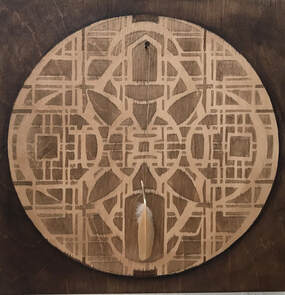|
When Henri Matisse famously observed in the early 20th century, "Exactitude is not truth," he was addressing the issue of academic art such as that of James Tissot, Jean-Léon Gérôme, painters from the end of the 19th century, both now largely forgotten. He was not thinking about Geometric Design. Geometry is generally considered to be more truthful when it is more exact. I have no argument with that notion as it is engaged in architecture and decorative design, but in the last few years I've been engaged with questions of geometry in painting. Might Geometry be embraced as a structural element in paintings where its inherent exactitude is subsumed and brought into play on behalf of other, perhaps more expressive, goals?
0 Comments
 New Remnant 34 New Remnant 34 We can very fittingly compare the nature of the soul to a very fine feather or very light wing. If it has not been damaged or affected by being spoiled by any moisture falling on it from outside, it is carried aloft almost naturally to the heights of heaven by the lightness of its nature, and the aid of the slightest breath. But if it is weighed down by any moisture falling on it and penetrating into it, it will not only not be carried away by its natural lightness into any flights in the sky, but it will actually be carried down to the depths of earth by the weight of the moisture it has received. In the same way our soul, if it is not weighed down with faults that touch it, and the cares of this world, or damaged by the moisture of injurious lusts, will be raised (so to speak) by the natural blessing of its own purity, and carried aloft to the heights by the light breath of spiritual meditation. Leaving things low and earthly, it will be transported to those that are heavenly and invisible. St. John Cassian  New Remnant #8, 8 x 10 inches. Walnut ink on cut clayboard, with chicken feather. New Remnant #8, 8 x 10 inches. Walnut ink on cut clayboard, with chicken feather. "St. Thomas Aquinas says that art does not require rectitude of the appetite, that it is wholly concerned with the good of that which is made. He says that a work of art is a good in itself, and this is a truth that the modern world has largely forgotten." -- Flannery O'Connor
|
AuthorI am an artist. I live in Minneapolis, Minnesota. Categories |





 RSS Feed
RSS Feed
